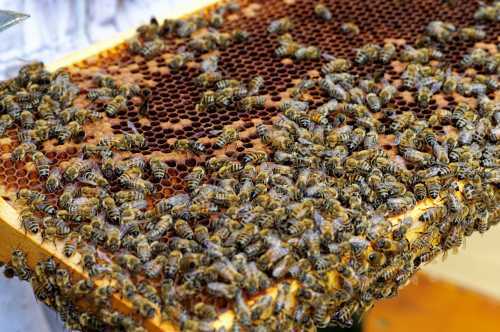The Buzzing Population: Understanding the Number of Bees in a Hive
Honey bee colonies are fascinating social structures that consist of thousands of individuals working together for the survival and prosperity of the hive. The number of bees in a hive can vary depending on several factors, such as the time of year, the health of the colony, and the size of the hive. In this comprehensive article, we will explore the typical population of a honey bee hive, the factors that influence it, and the importance of maintaining a healthy bee population.
The Anatomy of a Honey Bee Hive
A honey bee hive is composed of three main types of bees: the queen, the workers, and the drones. Each type plays a crucial role in the functioning of the colony.
- Queen Bee: The queen is the only fertile female in the hive and is responsible for laying eggs. She is larger than the other bees and has a longer abdomen.
- Worker Bees: Worker bees are the most numerous in the hive and are responsible for tasks such as cleaning, feeding the larvae, building comb, guarding the hive, and foraging for nectar and pollen.
- Drone Bees: Drones are the male bees in the hive and their primary function is to mate with the queen. They do not have stingers and do not participate in the daily tasks of the hive.
Typical Population of a Honey Bee Hive
The population of a honey bee hive can vary greatly depending on the time of year and the health of the colony. During the peak of the season, a healthy hive can contain up to 60,000 bees. However, the average population is typically around 30,000 to 50,000 bees.In early spring, the population of the hive is at its lowest, with only a few thousand bees. As the weather warms and the flowers bloom, the queen begins to lay more eggs, and the population rapidly increases. By late spring or early summer, the hive can reach its maximum population.As the season progresses and the weather cools in the fall, the population of the hive begins to decline. The queen lays fewer eggs, and the worker bees live longer to conserve resources for the winter. By the time winter arrives, the hive population can be as low as 10,000 to 20,000 bees.
Factors Influencing the Population of a Hive
Several factors can influence the population of a honey bee hive, including:
- Queen Health: The health and productivity of the queen directly impact the population of the hive. If the queen is old or unhealthy, she may lay fewer eggs, resulting in a smaller population.
- Availability of Resources: The availability of nectar and pollen can affect the population of the hive. If resources are scarce, the bees may not have enough food to support a large population.
- Weather Conditions: Extreme weather conditions, such as prolonged periods of rain or drought, can impact the availability of resources and the ability of the bees to forage.
- Diseases and Pests: Diseases and pests, such as varroa mites and American foulbrood, can weaken the hive and reduce its population.
- Swarming: Swarming is a natural process in which a portion of the hive’s population leaves to establish a new colony. This can result in a temporary reduction in the population of the original hive.
Importance of Maintaining a Healthy Bee Population
Maintaining a healthy bee population is crucial for the survival and productivity of the hive. A large population of worker bees ensures that there are enough individuals to perform the necessary tasks, such as foraging, building comb, and caring for the larvae.A healthy population also helps the hive to be more resilient to challenges such as disease, pests, and extreme weather conditions. If the population is too low, the hive may not have enough resources to survive the winter or to produce honey for the beekeeper.
Strategies for Maintaining a Healthy Bee Population
Beekeepers can employ several strategies to maintain a healthy bee population in their hives:
- Providing Adequate Resources: Ensuring that the bees have access to a variety of nectar and pollen sources throughout the season can help to support a healthy population.
- Monitoring for Diseases and Pests: Regular inspections and monitoring for diseases and pests can help to identify and address issues before they become serious.
- Replacing Old Queens: Replacing old or unproductive queens with younger, healthier ones can help to maintain a strong population.
- Preventing Swarming: Beekeepers can use techniques such as providing adequate space and ventilation in the hive to prevent swarming and maintain a strong population.
- Supplementing with Artificial Feeding: In times of resource scarcity, beekeepers may provide supplemental feeding to help maintain the health and population of the hive.
FAQ Section
Q1: What is the typical population of a honey bee hive?A1: The typical population of a honey bee hive can vary greatly depending on the time of year and the health of the colony. During the peak of the season, a healthy hive can contain up to 60,000 bees, but the average population is typically around 30,000 to 50,000 bees.
Q2: How does the population of a hive change throughout the year?A2: In early spring, the population of the hive is at its lowest, with only a few thousand bees. As the weather warms and the flowers bloom, the population rapidly increases. By late spring or early summer, the hive can reach its maximum population. As the season progresses and the weather cools in the fall, the population begins to decline.
Q3: What factors can influence the population of a hive?A3: Several factors can influence the population of a honey bee hive, including the health and productivity of the queen, the availability of nectar and pollen resources, weather conditions, diseases and pests, and swarming.
Q4: Why is maintaining a healthy bee population important?A4: Maintaining a healthy bee population is crucial for the survival and productivity of the hive. A large population of worker bees ensures that there are enough individuals to perform necessary tasks, and it helps the hive to be more resilient to challenges such as disease, pests, and extreme weather conditions.
Q5: What strategies can beekeepers use to maintain a healthy bee population?A5: Beekeepers can employ several strategies to maintain a healthy bee population, including providing adequate resources, monitoring for diseases and pests, replacing old queens, preventing swarming, and supplementing with artificial feeding.
Additional Information
| Topic | Description |
|---|---|
| Types of Bees | Queen, workers, drones |
| Typical Population | 30,000 to 50,000 bees during peak season |
| Factors Influencing Population | Queen health, resource availability, weather, diseases/pests, swarming |
| Importance of Healthy Population | Ensures necessary tasks are performed, increases resilience to challenges |
| Strategies for Maintaining Population | Providing resources, monitoring for issues, replacing queens, preventing swarming, supplemental feeding |
For more detailed information on honey bee biology and colony organization, you can refer to the Wikipedia article.
Conclusion
The population of a honey bee hive is a dynamic and fascinating aspect of these remarkable insects. Understanding the typical population size, the factors that influence it, and the importance of maintaining a healthy population is crucial for beekeepers and anyone interested in the well-being of these essential pollinators.By employing strategies to support the health and growth of honey bee colonies, we can help to ensure the continued success and prosperity of these incredible creatures. Whether you are a beekeeper or simply someone who appreciates the beauty and importance of honey bees, understanding the population dynamics of a hive is a fascinating and valuable piece of knowledge.



